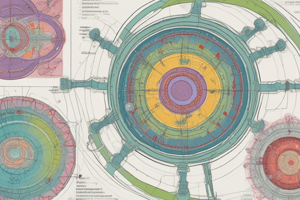Podcast
Questions and Answers
What happens to Rb protein in non-proliferating cells?
What happens to Rb protein in non-proliferating cells?
- It releases active E2F
- It binds to E2F, and the complex activates histone deacetylases (correct)
- It phosphorylates cyclin D-CDK4/6
- It binds to E2F, and the complex inhibits histone deacetylases
What is the role of TGFß in the cell cycle?
What is the role of TGFß in the cell cycle?
- Activation of E2F
- Phosphorylation of Rb
- Activation of G1 cyclin-CDKs
- Inhibition of G1 cyclin-CDKs (correct)
What happens to G1 cyclin-CDKs prior to the START point?
What happens to G1 cyclin-CDKs prior to the START point?
- They are inhibited
- They are phosphorylated
- They are synthesized
- They are degraded (correct)
What is the function of E2F in the cell cycle?
What is the function of E2F in the cell cycle?
What is the result of Rb inactivation?
What is the result of Rb inactivation?
What is the function of growth factors in the cell cycle?
What is the function of growth factors in the cell cycle?
What happens to Rb after degradation of mitotic cyclins at the end of mitosis?
What happens to Rb after degradation of mitotic cyclins at the end of mitosis?
What is the role of cyclin D-CDK4/6 in the cell cycle?
What is the role of cyclin D-CDK4/6 in the cell cycle?
What happens to the cell after the restriction point?
What happens to the cell after the restriction point?
What is the result of E2F activation?
What is the result of E2F activation?
Study Notes
Cyclins and Kinases
- Cyclins are a family of proteins that control the progression of cells through the cell cycle by activating cyclin-dependent kinase (Cdk) enzymes.
- Cyclins were originally named because their concentration varies in a cyclical fashion during the cell cycle.
- A kinase is a type of enzyme that transfers phosphate groups from high-energy donor molecules, such as ATP, to specific substrates, a process referred to as phosphorylation.
Cyclins vs. Kinases
- Certain cyclins are made at certain times during the cell cycle, and their concentration will rise and fall.
- Cyclins are also destroyed after they are no longer needed by the cell.
- CDKs are not destroyed as they are only activated or deactivated.
Kinases Phosphorylate Cell Signal Molecules
- Certain kinases may have two forms (active and inactive).
- Kinases are enzymes (proteins) that phosphorylate certain molecules or other enzymes.
- Most cell cycle signals are phosphorylated by kinases.
Cyclins Activate Kinases
- Most cell cycle kinases are activated by molecules called cyclins.
- A kinase that requires a cyclin for activation is called a cyclin-dependent kinase or Cdk.
- The cyclin attaches to the Cdk, forming a cyclin-Cdk complex.
MPF (Maturation-Promoting Factor)
- MPF is activated at the end of G2 by a phosphatase, which removes an inhibitory phosphate group added earlier.
- MPF is also called the M phase kinase because of its ability to phosphorylate target proteins at a specific point in the cell cycle and thus control their ability to function.
- MPF promotes the entrance into mitosis (the M phase) from the G2 phase by phosphorylating multiple proteins needed during mitosis.
Cyclin Destruction
- Once the CDK phosphorylates certain signals, the cyclin is destroyed.
- In the cell, the concentration of cyclins will rise and fall depending on the phase of the cell cycle.
- When the cyclin is destroyed, the Cdk returns to an inactive form.
Cyclin Types
- Different types of cyclins include:
- Cyclin D: drives the transition G1 → S
- Cyclin E: commits the cell to DNA replication
- Cyclin A: necessary for the initiation of DNA replication
- Cyclin B: promotes the events of Mitosis
Cyclins/CDKs Control the Cell Cycle
- The cell cycle has several external and internal checkpoints, which involve chemical signals that have been phosphorylated by cyclin-CDK complexes.
- G1/S (R point) checkpoint is the primary determining factor for cell division to take place.
- The G2 checkpoint represents the commitment for starting the process of mitosis.
- The M/spindle checkpoint ensures that all the chromosomes are attached to the spindle in preparation of mitosis.
External Signals Affect Cell Division
- External signals, such as growth factors, can affect cell division.
- Mammalian cells need certain nutrients and regulatory proteins to divide.
- Growth factors can turn on the transcription of early response genes, which in turn activate the transcription of delayed-response genes, including G1 cyclin-CDKs.
Studying That Suits You
Use AI to generate personalized quizzes and flashcards to suit your learning preferences.
Related Documents
Description
Learn about the role of cyclins and kinases in regulating the cell cycle, including the activation of cyclin-dependent kinase enzymes and the process of phosphorylation.




